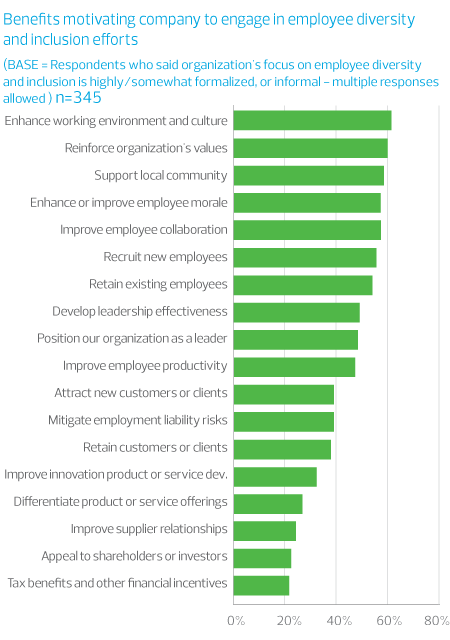A focus on diversity and inclusion is significant for many middle market businesses. According to the MMBI, over half (55 percent) of middle market executives describe their organization’s focus on employee diversity and inclusion as highly or somewhat formalized, and among executives from larger organizations, over two-thirds say it is formalized. Among those with at least an informal focus, 64 percent focus their efforts on multicultural issues.
Most executives indicated their organizations are motivated to pursue diversity and inclusion efforts as a means to:
- Enhance their working environment and culture (61 percent)
- Reinforce their organization’s values (60 percent)
- Support the local community (58 percent)
- Enhance or improve employee morale (57 percent)
- Improve employee collaboration (57 percent), recruiting (55 percent) or retention (54 percent)
CDI formalization: Workforce, workplace, marketplace and community
So how does a middle market company create a more formalized CDI plan or enhance an existing one? "RSM’s strategy included an examination of four pillars: workforce, workplace, marketplace and community," says Walker, adding that other businesses could adopt and benefit from the same approach.
Walker says exploring workforce involves focusing on employees asking questions like:
- How diverse is our employee population?
- How are we meeting the needs of our diverse employees?
- Do we need a different recruiting strategy to expand the diversity in our workforce?
And for workplace, she indicates businesses should examine organizational behavior, including exploring:
- Do we have employee network and affinity groups?
- Do we have a diversity council?
- Do we have training on unconscious bias, cultural dexterity and resources for our existing workforce?
Assessing the marketplace means turning attentions externally and evaluating areas that include:
- How did the firm communicate CDI efforts to clients, prospects and customers?
- Was the right advertising used?
- Was the organization sponsoring the appropriate events?
And finally, it's important to assess local, regional and national community, Walker says, adding that's where CSR truly comes in.
- How does the organization show the intentions around charity, diversity and inclusion and leverage the work and planning by supporting nonprofits and volunteering?
Walker says for RSM, it was a five-year process working through the various pillars; however, the time was well spent. The firm has seen significant gains related to employee engagement and recruiting since CDI's launch.
Enhance your planning
In addition to creating a more formalized CDI strategy, companies may consider four areas for further differentiation and program maturity. A study conducted by Accenture notes the following diversity and inclusion opportunities some companies might consider to enhance their efforts:
- Regularly review talent pipelines and/or monitor attrition and promotion rates for diverse talent
- Employ a focused recruitment strategy that targets diverse populations
- Clearly state diversity and inclusion in the global business strategy
- Ensure leadership is aware of legal obligation and ambitions related to diversity and inclusion, and that these efforts are measured and rewarded when results are achieved


